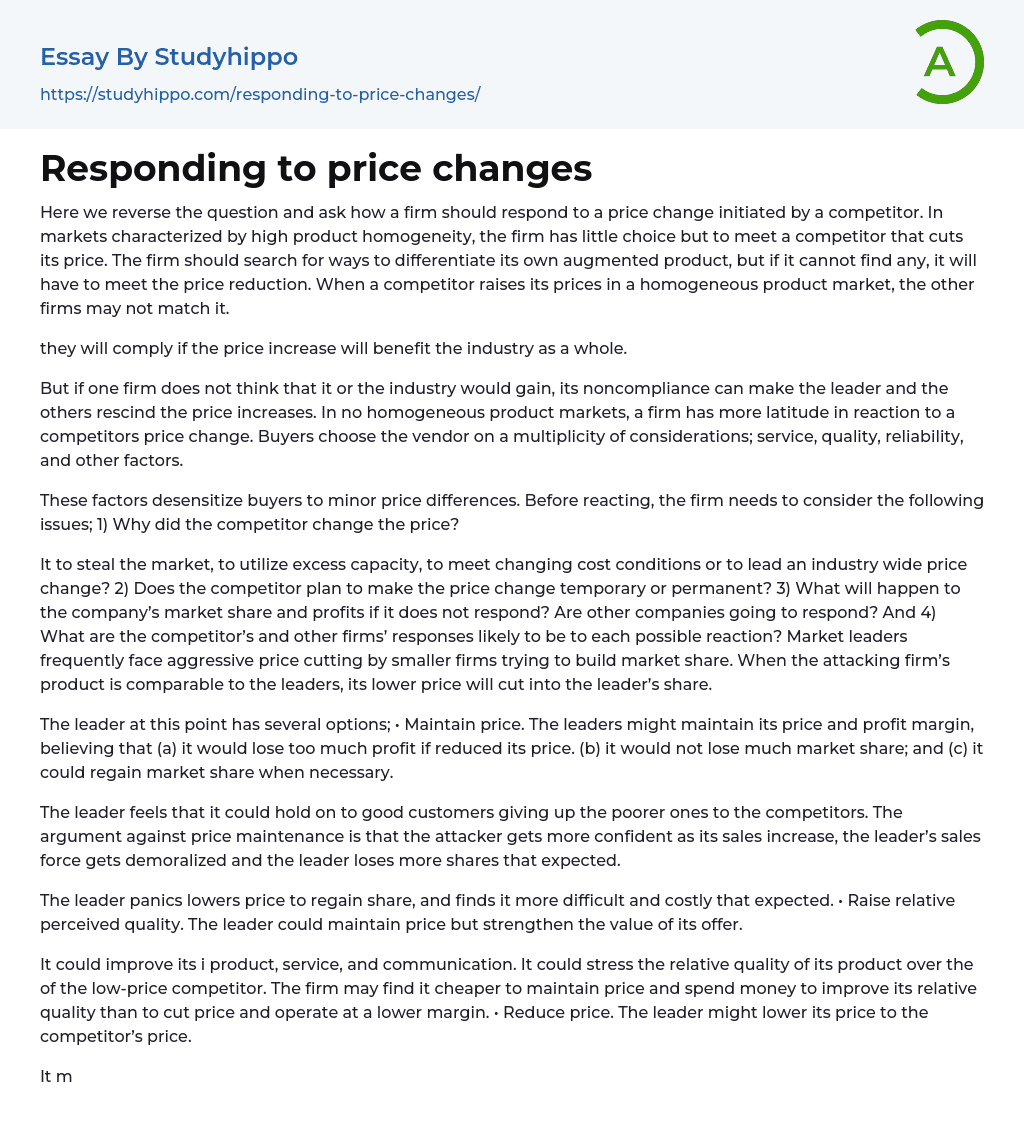Here we reverse the question and ask how a firm should respond to a price change initiated by a competitor. In markets characterized by high product homogeneity, the firm has little choice but to meet a competitor that cuts its price. The firm should search for ways to differentiate its own augmented product, but if it cannot find any, it will have to meet the price reduction. When a competitor raises its prices in a homogeneous product market, the other firms may not match it.
they will comply if the price increase will benefit the industry as a whole.
But if one firm does not think that it or the industry would gain, its noncompliance can make the leader and the others rescind the price increases. In no homogeneous product markets, a firm has more latitude in reaction to a compe
...titors price change. Buyers choose the vendor on a multiplicity of considerations; service, quality, reliability, and other factors.
These factors desensitize buyers to minor price differences. Before reacting, the firm needs to consider the following issues; 1) Why did the competitor change the price?
It to steal the market, to utilize excess capacity, to meet changing cost conditions or to lead an industry wide price change? 2) Does the competitor plan to make the price change temporary or permanent? 3) What will happen to the company’s market share and profits if it does not respond? Are other companies going to respond? And 4) What are the competitor’s and other firms’ responses likely to be to each possible reaction? Market leaders frequently face aggressive price cutting by smaller firms trying to buil
market share. When the attacking firm’s product is comparable to the leaders, its lower price will cut into the leader’s share.
The leader at this point has several options; • Maintain price. The leaders might maintain its price and profit margin, believing that (a) it would lose too much profit if reduced its price. (b) it would not lose much market share; and (c) it could regain market share when necessary.
The leader feels that it could hold on to good customers giving up the poorer ones to the competitors. The argument against price maintenance is that the attacker gets more confident as its sales increase, the leader’s sales force gets demoralized and the leader loses more shares that expected.
The leader panics lowers price to regain share, and finds it more difficult and costly that expected. • Raise relative perceived quality. The leader could maintain price but strengthen the value of its offer.
It could improve its i product, service, and communication. It could stress the relative quality of its product over the of the low-price competitor. The firm may find it cheaper to maintain price and spend money to improve its relative quality than to cut price and operate at a lower margin. • Reduce price. The leader might lower its price to the competitor’s price.
It might do this because (A) its costs fall with volume (b) it would lose a lot of share because the market is price sensitivity and (c) it would be hard to rebuild market share once it is lost. This action will cut its profits in the short run. Some firms will reduce their
product quality, services, and marketing communications to maintain profits, but this will ultimately hurt their long-run market share. The company should try to maintain the value of its offer as it cuts prices.
• Increase price and improve quality. The leader might raise its price and introduce some new brands to brackets the attacking brand.
• Launch ;price fighter line. One of the best responses is to add lower-price items to the line or to create a separate lower-price brand. This is necessary if the particular market segment being lost is price-sensitive, since it will not respond to arguments of higher quality. The best response requires an analysis of the particular situation.
The company under attack has to consider the products stage in the life cycle, its importance in the company’s product portfolio the intentions and resources of the competitor, the price and value sensitivity of the market, the behavior of costs with volume and the company’s alternative opportunities.
An extended analysis of company alternatives is not always feasible at the time of a price change. The competitor may have spent considerable time in preparing this decision, but the company may have to react decisively within hours or days. About the only way to cut down price reaction decision time is to anticipate possible competitors price changes and to prepare contingent response.
Reaction programs for meeting price changes find their greatest application in industry where price changes occur with some frequency and where it is important to react quickly.
- Wal-Mart essays
- Discover essays
- Advertisement essays
- Advertising essays
- Anheuser-busch essays
- Audience Theory essays
- Brand essays
- Brands essays
- Competitor Analysis essays
- Consumer essays
- Detergent essays
- Marketing Management essays
- Marketing Mix essays
- Marketing Plan essays
- Marketing Research essays
- Marketing Strategy essays
- New Product Development essays
- Point Of Sale essays
- Price essays
- Procurement essays
- Product essays
- Product Differentiation essays
- Product Placement essays
- Promotion essays
- Promotion And Marketing Communications essays
- Research Design essays
- Retailing essays
- Trademark essays
- Adaptation essays
- Adventure essays
- Adversity essays
- Aging essays
- Alcohol essays
- Barbie Doll essays
- Beauty essays
- Care essays
- Carpe diem essays
- Change essays
- Chess essays
- Chicken essays
- Choices essays
- Contrast essays
- Crops essays
- Development essays
- Dream essays
- Evil essays
- Experience essays
- Family essays
- Farm essays
- Fire essays




